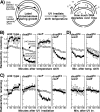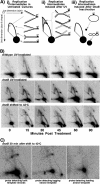Inactivation of the DnaB helicase leads to the collapse and degradation of the replication fork: a comparison to UV-induced arrest
- PMID: 17526695
- PMCID: PMC1951839
- DOI: 10.1128/JB.00408-07
Inactivation of the DnaB helicase leads to the collapse and degradation of the replication fork: a comparison to UV-induced arrest
Abstract
Replication forks face a variety of structurally diverse impediments that can prevent them from completing their task. The mechanism by which cells overcome these hurdles is likely to vary depending on the nature of the obstacle and the strand in which the impediment is encountered. Both UV-induced DNA damage and thermosensitive replication proteins have been used in model systems to inhibit DNA replication and characterize the mechanism by which it recovers. In this study, we examined the molecular events that occur at replication forks following inactivation of a thermosensitive DnaB helicase and found that they are distinct from those that occur following arrest at UV-induced DNA damage. Following UV-induced DNA damage, the integrity of replication forks is maintained and protected from extensive degradation by RecA, RecF, RecO, and RecR until replication can resume. By contrast, inactivation of DnaB results in extensive degradation of the nascent and leading-strand template DNA and a loss of replication fork integrity as monitored by two-dimensional agarose gel analysis. The degradation that occurs following DnaB inactivation partially depends on several genes, including recF, recO, recR, recJ, recG, and xonA. Furthermore, the thermosensitive DnaB allele prevents UV-induced DNA degradation from occurring following arrest even at the permissive temperature, suggesting a role for DnaB prior to loading of the RecFOR proteins. We discuss these observations in relation to potential models for both UV-induced and DnaB(Ts)-mediated replication inhibition.
Figures






Similar articles
-
RecO acts with RecF and RecR to protect and maintain replication forks blocked by UV-induced DNA damage in Escherichia coli.J Biol Chem. 2004 Jan 30;279(5):3492-6. doi: 10.1074/jbc.M311012200. Epub 2003 Nov 18. J Biol Chem. 2004. PMID: 14625283
-
Direct rescue of stalled DNA replication forks via the combined action of PriA and RecG helicase activities.Mol Cell. 2002 Feb;9(2):241-51. doi: 10.1016/s1097-2765(02)00455-0. Mol Cell. 2002. PMID: 11864599
-
RecQ and RecJ process blocked replication forks prior to the resumption of replication in UV-irradiated Escherichia coli.Mol Gen Genet. 1999 Oct;262(3):543-51. doi: 10.1007/s004380051116. Mol Gen Genet. 1999. PMID: 10589843
-
Single-molecule analysis of the Escherichia coli replisome and use of clamps to bypass replication barriers.FEBS Lett. 2010 Jun 18;584(12):2596-605. doi: 10.1016/j.febslet.2010.04.003. Epub 2010 Apr 11. FEBS Lett. 2010. PMID: 20388515 Free PMC article. Review.
-
Participation of recombination proteins in rescue of arrested replication forks in UV-irradiated Escherichia coli need not involve recombination.Proc Natl Acad Sci U S A. 2001 Jul 17;98(15):8196-202. doi: 10.1073/pnas.121008898. Proc Natl Acad Sci U S A. 2001. PMID: 11459953 Free PMC article. Review.
Cited by
-
UvrD Participation in Nucleotide Excision Repair Is Required for the Recovery of DNA Synthesis following UV-Induced Damage in Escherichia coli.J Nucleic Acids. 2012;2012:271453. doi: 10.1155/2012/271453. Epub 2012 Sep 27. J Nucleic Acids. 2012. PMID: 23056919 Free PMC article.
-
Recombination Mediator Proteins: Misnomers That Are Key to Understanding the Genomic Instabilities in Cancer.Genes (Basel). 2022 Feb 27;13(3):437. doi: 10.3390/genes13030437. Genes (Basel). 2022. PMID: 35327990 Free PMC article. Review.
-
SSB as an organizer/mobilizer of genome maintenance complexes.Crit Rev Biochem Mol Biol. 2008 Sep-Oct;43(5):289-318. doi: 10.1080/10409230802341296. Crit Rev Biochem Mol Biol. 2008. PMID: 18937104 Free PMC article. Review.
-
Rescuing stalled or damaged replication forks.Cold Spring Harb Perspect Biol. 2013 May 1;5(5):a012815. doi: 10.1101/cshperspect.a012815. Cold Spring Harb Perspect Biol. 2013. PMID: 23637285 Free PMC article. Review.
-
Events associated with DNA replication disruption are not observed in hydrogen peroxide-treated Escherichia coli.G3 (Bethesda). 2021 Apr 15;11(4):jkab044. doi: 10.1093/g3journal/jkab044. G3 (Bethesda). 2021. PMID: 33591320 Free PMC article.
References
-
- Bedale, W. A., R. B. Inman, and M. M. Cox. 1993. A reverse DNA strand exchange mediated by recA protein and exonuclease I. The generation of apparent DNA strand breaks by recA protein is explained. J. Biol. Chem. 268:15004-15016. - PubMed
-
- Capaldo, F. N., and S. D. Barbour. 1975. The role of the rec genes in the viability of Escherichia coli K12. Basic Life Sci. 5A:405-418. - PubMed
-
- Carl, P. L. 1970. Escherichia coli mutants with temperature-sensitive synthesis of DNA. Mol. Gen. Genet. 109:107-122. - PubMed
Publication types
MeSH terms
Substances
Grants and funding
LinkOut - more resources
Full Text Sources
Molecular Biology Databases

